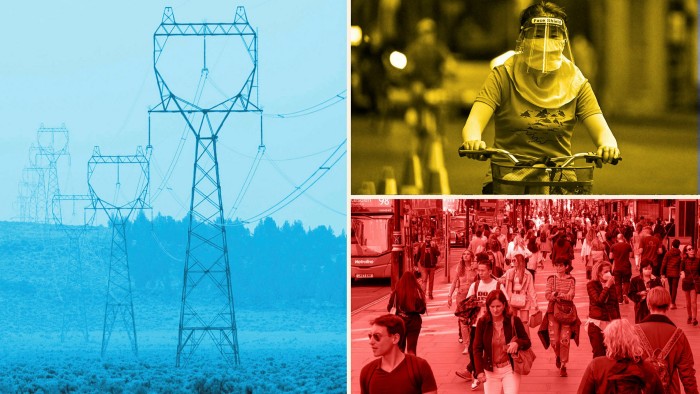Did US inflation accelerate again in June?

Simply sign up to the Global Economy myFT Digest -- delivered directly to your inbox.
Did US inflation accelerate in June?
The rate of US price increases is expected to have pushed higher in June, propelled by the soaring costs of energy, food and shelter.
Economists polled by Reuters are forecasting annual inflation of 8.7 per cent in June, up from 8.6 per cent the previous month. Monthly consumer price growth is expected to have remained flat at 1 per cent in June from May, driven by high energy prices.
“Inflation is likely to move even further above target this coming week as gasoline, food, shelter and airline fares continue to rise apace,” said James Knightley, chief international economist at ING Financial Markets.
Core inflation, which excludes volatile items such as food and energy, is expected to increase 0.5 per cent, down from the previous month’s 0.6 per cent increase. The slowdown is forecast to have been driven by “reduced impetus” from used cars and apparel, Knightley said.
Inflation was projected to have peaked in March, after the US consumer price index moderated for the first time in eight months in April to 8.3 per cent. However, consumer prices then continued to accelerate in May, hitting an annualised rate of 8.6 per cent because of rising energy and food prices.
The Federal Reserve raised interest rates last month by 0.75 percentage points — the most in almost three decades — which could begin to weigh on consumer spending. Recent data, including May personal consumption expenditure report and a revision to the first-quarter GDP figures, showed personal consumption has weakened.
“There are clear indications that goods prices, excluding food, energy and autos, are under pressure but these have a very low weight in the CPI, maybe 10-15 per cent,” said Steve Englander, a strategist at Standard Chartered.
A slowdown in consumer spending will probably not impact the June report, Knightley said, but weak consumer confidence, rising interest rates and inflation eating into spending power may pressure consumer demand in the coming months. Alexandra White
How much did China’s lockdowns slow GDP growth in the second quarter?
At one point in mid-April, Japanese investment bank Nomura estimated that as many as 45 Chinese cities and 373mn people were under some form of Covid-19 lockdown, while life in the country’s most important economic hub of Shanghai ground to a halt as residents were confined to their homes and businesses shuttered.
Those lockdowns, many of which lasted in some form well into May, led global banks to downgrade their annual gross domestic product forecasts for the world’s second-largest economy. The shutdowns even prompted a rare intervention from the country’s premier Li Keqiang, who warned that China might struggle to post growth at all in the second quarter.
And while forecasts suggest that concern may be overblown, consensus estimates of 1.2 per cent year-on-year growth would put the economy on track for its slowest expansion since the early days of the pandemic. Analysts add that the slowdown will be cushioned slightly by a factory-led economic recovery in June as lockdowns eased. Consumer spending, meanwhile, has been harder to stimulate.
“While overall activity growth would be stronger in June, the very sluggish growth in April and only modest recovery in May imply that for Q2 as a whole, real GDP growth will probably slow materially from Q1 on the back of Covid resurgence and strict lockdown measures in April and the first half of May,” analysts from US bank Goldman Sachs wrote in a note this week.
Looking forward, the question is whether the country can achieve its annual growth target of 5.5 per cent, a figure most economists think is overly ambitious even if it does manage to prevent any further lockdowns. William Langley
What will fresh GDP data reveal about the health of the UK economy?
The UK economy is expected to have flatlined in May as a cost of living crisis hits household finances.
Economists polled by Reuters expect UK GDP to be unchanged between April and May when figures are released on Wednesday. This would mark the fourth consecutive month with no growth.
“It is likely the rising cost of living continued to impact the UK economy,” said Sandra Horsfield, economist at Investec. She added that the negative impact of increasing prices is unlikely to be offset by a potential rebound in the production sector from a weak April.
In May, consumers faced not only the highest inflation in 30 years but also an uptick in national insurance contributions. Official retail sales figures already showed consumers reined in spending as a result.
George Buckley, economist at Nomura noted that while the hospitality and leisure sectors might continue their recovery from lockdowns, that could be offset by a further drop in healthcare.
The overall picture is of the worst combination of surging prices and falling activity since the 1970s, and one that is likely to deteriorate in the months ahead.
Huw Pill, chief economist at the Bank of England, expects that “the real income squeeze coming from higher international energy and goods prices will slow domestic demand, and eventually result in the emergence of economic slack . . .[and] higher unemployment.”
Horsfield forecast that the UK economy would enter a recession later this year and into the first quarter of next year because of strong inflation pressures and higher interest rates.
However, she added that “the strength of consumer and bank balance sheets gives us hope the recession will remain relatively mild — provided a full shutdown of Russian gas flows to Europe is averted.” Valentina Romei
FT survey: How are you handling higher inflation?

We are exploring the impact of rising living costs on people around the world and want to hear from readers about what you are doing to combat costs. Tell us via a short survey.
Comments